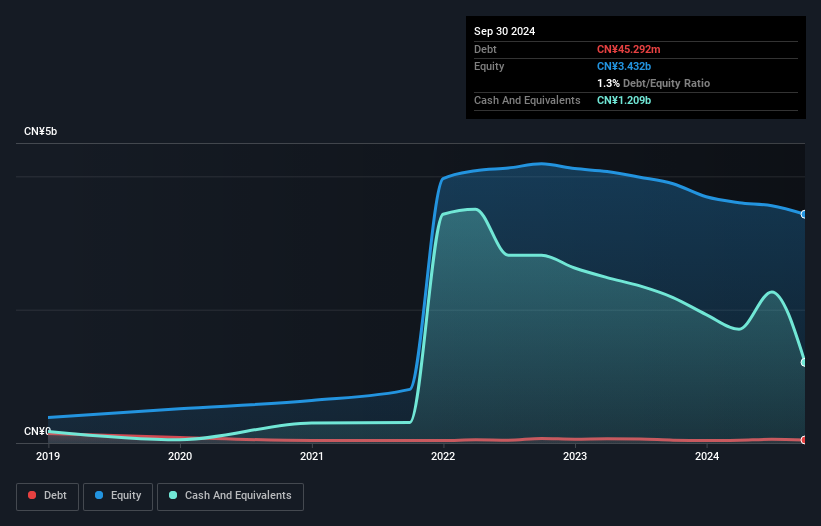David Iben put it well when he said, 'Volatility is not a risk we care about. What we care about is avoiding the permanent loss of capital.' So it might be obvious that you need to consider debt, when you think about how risky any given stock is, because too much debt can sink a company. We can see that Dosilicon Co., Ltd. (SHSE:688110) does use debt in its business. But should shareholders be worried about its use of debt?
Why Does Debt Bring Risk?
Debt and other liabilities become risky for a business when it cannot easily fulfill those obligations, either with free cash flow or by raising capital at an attractive price. In the worst case scenario, a company can go bankrupt if it cannot pay its creditors. However, a more usual (but still expensive) situation is where a company must dilute shareholders at a cheap share price simply to get debt under control. Having said that, the most common situation is where a company manages its debt reasonably well - and to its own advantage. The first thing to do when considering how much debt a business uses is to look at its cash and debt together.
View our latest analysis for Dosilicon
What Is Dosilicon's Net Debt?
The image below, which you can click on for greater detail, shows that at September 2024 Dosilicon had debt of CN¥45.3m, up from CN¥42.4m in one year. But on the other hand it also has CN¥1.21b in cash, leading to a CN¥1.16b net cash position.

How Strong Is Dosilicon's Balance Sheet?
According to the last reported balance sheet, Dosilicon had liabilities of CN¥156.9m due within 12 months, and liabilities of CN¥34.4m due beyond 12 months. On the other hand, it had cash of CN¥1.21b and CN¥106.3m worth of receivables due within a year. So it actually has CN¥1.12b more liquid assets than total liabilities.
This surplus suggests that Dosilicon has a conservative balance sheet, and could probably eliminate its debt without much difficulty. Simply put, the fact that Dosilicon has more cash than debt is arguably a good indication that it can manage its debt safely. The balance sheet is clearly the area to focus on when you are analysing debt. But it is future earnings, more than anything, that will determine Dosilicon's ability to maintain a healthy balance sheet going forward. So if you want to see what the professionals think, you might find this free report on analyst profit forecasts to be interesting.
Over 12 months, Dosilicon reported revenue of CN¥606m, which is a gain of 6.5%, although it did not report any earnings before interest and tax. That rate of growth is a bit slow for our taste, but it takes all types to make a world.
So How Risky Is Dosilicon?
We have no doubt that loss making companies are, in general, riskier than profitable ones. And we do note that Dosilicon had an earnings before interest and tax (EBIT) loss, over the last year. And over the same period it saw negative free cash outflow of CN¥345m and booked a CN¥290m accounting loss. But the saving grace is the CN¥1.16b on the balance sheet. That kitty means the company can keep spending for growth for at least two years, at current rates. Even though its balance sheet seems sufficiently liquid, debt always makes us a little nervous if a company doesn't produce free cash flow regularly. The balance sheet is clearly the area to focus on when you are analysing debt. But ultimately, every company can contain risks that exist outside of the balance sheet. To that end, you should be aware of the 1 warning sign we've spotted with Dosilicon .
If, after all that, you're more interested in a fast growing company with a rock-solid balance sheet, then check out our list of net cash growth stocks without delay.
New: Manage All Your Stock Portfolios in One Place
We've created the ultimate portfolio companion for stock investors, and it's free.
• Connect an unlimited number of Portfolios and see your total in one currency
• Be alerted to new Warning Signs or Risks via email or mobile
• Track the Fair Value of your stocks
Have feedback on this article? Concerned about the content? Get in touch with us directly. Alternatively, email editorial-team (at) simplywallst.com.
This article by Simply Wall St is general in nature. We provide commentary based on historical data and analyst forecasts only using an unbiased methodology and our articles are not intended to be financial advice. It does not constitute a recommendation to buy or sell any stock, and does not take account of your objectives, or your financial situation. We aim to bring you long-term focused analysis driven by fundamental data. Note that our analysis may not factor in the latest price-sensitive company announcements or qualitative material. Simply Wall St has no position in any stocks mentioned.
About SHSE:688110
Dosilicon
A fabless memory solution company, designs, produces, and sells memory chips worldwide.
Flawless balance sheet with high growth potential.
Market Insights
Community Narratives



